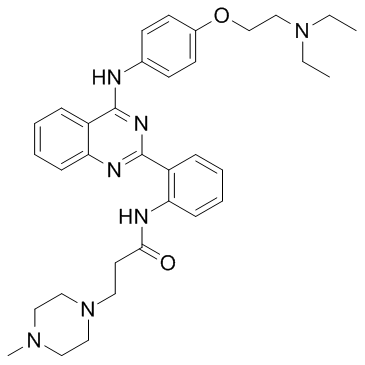| Cas No.: | 1637443-98-1 |
| Chemical Name: | hVEGF-IN-1 |
| Synonyms: | hVEGF-IN-1 |
| SMILES: | CCN(CC)CCOC(C=C1)=CC=C1NC2=NC(C3=C(NC(CCN4CCN(C)CC4)=O)C=CC=C3)=NC5=CC=CC=C52 |
| Purity: | >98% |
| Sotrage: | 2 years -20°C Powder, 2 weeks 4°C in DMSO, 6 months -80°C in DMSO |
| Description: | hVEGF-IN-1 represses human VEGF-A translation and shows antitumor activity. In Vivo: Tumor bearing mice treated with hVEGF-IN-1 have an average tumor volume of less than 300 mm3. The tumor weight in the presence of hVEGF-IN-1 reduces around 60.1% to a final weight of 0.18 g. No significant change in body weight is observed during the treatment. |
| In Vivo: | Tumor bearing mice treated with hVEGF-IN-1 have an average tumor volume of less than 300 mm3. The tumor weight in the presence of hVEGF-IN-1 reduces around 60.1% to a final weight of 0.18 g. No significant change in body weight is observed during the treatment[1]. |
| In Vitro: | hVEGF-IN-1 shows a significant specific interaction with the G-rich region within the 5′- untranslated regions (5′-UTR) of hVEGF-A mRNA and destabilizes the Gquadruplex structure. hVEGF-IN-1 binds to the IRES-A (WT) with a Kd of 0.928 μM and binds to the hairpin DNA with a Kd of 21.2 μM. The G-rich sequence G774-G790 within the IRES-A of hVEGF-A’s 5′-UTR has been shown to be critical for the translation initiation activity of IRES-A. hVEGF-IN-1 hinders BG4 from binding to the IRES-A RNA G-quadruplex in cells. hVEGF-IN-1 down-regulates hVEGF-A’s translation via the G-quadruplex within IRES-A mRNA. hVEGF-IN-1 treatment reduces MDA-MB- 231 cell migration to approximately 25%[1]. |
| Cell Assay: | MDA-MB-231 cells are plated in the top chambers of 0.8 μm pore trans-wells in Opti-MEM reduced serum medium in the presence or absence of hVEGF-IN-1. Meanwhile, 600 μL of DMEM containing 10% fetal bovine serum (FBS) and 100 μM CoCl2 are added to the lower chambers. The cells are allowed to migrate for 24 h. At the end of the assay, the cells in the top chamber are removed, and the cells at the bottom of the filter are treated by adding 500 μL of DMEM containing 2.5 mg/mL MTT to each well. After incubating at 37 °C with 5% CO2 for 4 h, 500 μL of DMSO is added to each well and the plate is gently rotated for 10 min. Absorbance (570 nm) is measured using a microplate reader[1]. |
| Animal Administration: | Mice: Mice are separated into three groups: negative control, compound 1-treated, and positive control (doxorubicin-treated). hVEGF-IN-1, doxorubicin, and saline are administered by ip injection to athymic nude mice with human tumor xenografts established using MCF-7 breast cancer cells. Mice are injected ip once a day for 20 days. Negative controls are injected with 150 μL of saline. The positive control group received doxorubicin by ip injection at a dose of 1 mg/kg. hVEGF-IN-1 is similarly administered to mice at a dose of 7.5 mg/kg. After treating the animals for 20 days, the tumor tissues are collected and IHC assays are conducted using an anti-VEGF-A antibody[1]. |
| References: | [1]. Discovery of Small Molecules for Repressing Cap-Independent Translation of Human VascularEndothelial Growth Factor (hVEGF) as Novel Antitumor Agents. J Med Chem. 2017 Jul 13;60(13):5306-5319. |

 DC Chemicals' products qualify for U.S. tariff exemptions. We guarantee no price increases due to customs duties and maintain stable supply, continuing to deliver reliable research solutions to our American clients.
DC Chemicals' products qualify for U.S. tariff exemptions. We guarantee no price increases due to customs duties and maintain stable supply, continuing to deliver reliable research solutions to our American clients.





















